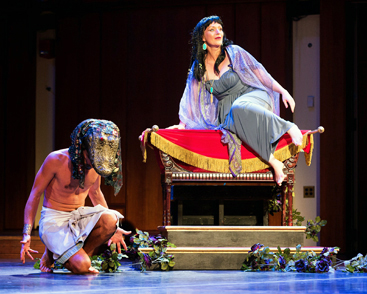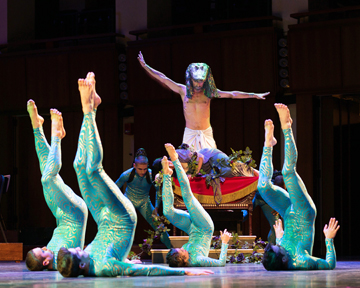Dance: A Baroque Spectacle
By Dawn Lille
ART TIMES November online 2014
 Bass François Lis and soprano Ingrid Perruche in rehearsal of Opera Lafayette's production of Rameau's Les Fêtes de l'Hymen et de l'Amour (photographer Louis Forget) |
Les Fetes de l’Hymen et de l’Amour ou Les Dieux d’Egypte [The Festivals of Hymen and Amour or The Gods of Egypt] with music by Jean-Philippe Rameau and libretto by Louis de Cahusac was first presented at Versailles in 1747 to celebrate the second wedding of Louis XV’s son. Opera Lafayette of Washington, D.C., under the direction of Ryan Brown, has reconstructed this opera/ballet to celebrate its own 20th birthday and the 250th Anniversary of Rameau’s death.
The resulting spectacle explores the world of Egyptian mythology as originally produced for an audience that was not concerned with historical truth or verite in sets or costumes, and had no trouble seeing an Egyptian dance a gavotte. They willingly accepted any fantasy taking place on stage and it is in this spirit that one had to approach this special production.
Rameau had just completed a heroic ballet in three acts about the gods of Egypt. In the political rush to expedite this royal wedding they put together a prologue that related the performance to the young bride and groom and the power of their unity.
Brown decided that there would be three choreographers in this reconstruction: Catherine Turocy, director of the New York Baroque Dance Company, Anuradha Nehru, director of Kalanidhi, a classical Indian troupe, and Sean Curran, director of the Sean Curran Company, which presents modern dance.
Rameau really wrote this piece to be danced; it was the first time dance was a seamless part of the narrative, describing action. In this sense Opera Lafayette’s performance is following the composer’s desires, and even the three- choreographer version is adhering to the Baroque concept of unity and balance within diversity.
 Tenor Jeffrey Thompson with members of the New York Baroque Dance Company in rehearsal of Opera Lafayette's production of Rameau's Les Fêtes de l'Hymen et de l'Amour (photographer Louis Forget) |
In the Overture there was a female dancer in a flowing yellow dress carrying, and at times waving, a large French flag. Her consort was a tall young man dressed in red and white striped pants, a navy blue tailcoat and a striped high hat. She seemed to be France and he America and their delightful chase duet, choreographed by Curran, was reminiscent of English music hall. It could also have inferred the joyful joining together of two diverse characters.
The Prologue featured Amour (love), who was afraid that Hymen (marriage) would overwhelm his court. But Hymen arrived surrounded by virtues and they agreed to unite and to protect the young Dauphin and Dauphine. Turocy’s choreography and her company brought this section charmingly to life. Their light, airy, precise steps and gestures and knowing looks surrounded Amour as they embodied the Graces and Virtues, almost enlarging or echoing the beautiful sounds of the chorus. One of the characters, a gift from Hymen to Amour, was a long necked ostrich, whose prances delighted the audience and showed the humor often found in Baroque dance. The music and the expressive dancing body seemed to be one in this section.
Act I, Osiris, was choreographed by Nehru and danced by her company. In this section Orthesie, queen of the Amazons, prepared to battle the Egyptian god Osiris. But he came as a bringer of peace, with his gifts of the seasons, fruits and flowers depicted as a danced divertissement. A group of Amazons came prepared to kill Osiris but he and Orthesie declared their mutual love, which was celebrated in movement.
The Indian dancers, using their fluid arms, hands and torsos, were gentle in embodying Osiris’s gifts. In their wide, deep plies they used bows for their original attack positions as Amazons. Their communicative backs and subtle head positions seemed to listen to the music. When their feet picked up the orchestral rhythms and responded to them we heard classical Indian technique joined with Rameau’s musical approach. At the end the Baroque dancers intermingled with them and the result was a refreshingly new, elegant and mind expanding melding of styles.
 Bass François Lis, soprano Ingrid Perruche and members of the Seán Curran Company in rehearsal of Opera Lafayette's production of Rameau's Les Fêtes de l'Hymen et de l'Amour (photographer Louis Forget) |
Sean Curran choreographed Act II, Canope, the god of the river. Disguised as a mortal, Nilee, Canope is in love with Memphis, who returns his affection. When she is chosen to be the sacrificial victim in his honor, Canope comes with his retinue, stops the priests and orders the people to leave. She awakens, eventually realizes who he is and all are united after they exchange vows of love.
The Curran dancers, dressed in long sleeved turquoise unitards with gold designs, were the water nymphs or waves of the retinue. But their arm and body movements, meant to represent water, seemed to have no movement source, making them resemble wiggling worms that repeated their gestures interminably.
On the few occasions they jumped or leaped they came to life and at times one could hear a bit of the Irish step dances Curran performed years ago.
The Baroque dancers portrayed Egyptians in this act and there was some interweaving at the end, but it looked a bit awkward in between the wiggles.
The final act, Arueris, was directed by Turocy, with input from all the dancers and choreographers. Here, under her careful watch, the three styles seemed to meld in telling the story of the competition among the arts in honor of the goddess Isis, as overseen by Arueris, god of the arts. Isis, garbed in a compelling gold costume with arms extended via wooden poles in the sleeves (think of the early modern dancer Loie Fuller) encouraged all to join together.
This was an evening to delight both the eye and ear. One must thank Brown for his eagerness to take the Baroque out of its box and Turocy for probing all the dance, drama and art sources of the period to bolster her belief that this form is relevant today. There was a great variety of dances in the 18 th century and in Rameau’s music, and they are generous in sharing.
dawnlille@aol.com
